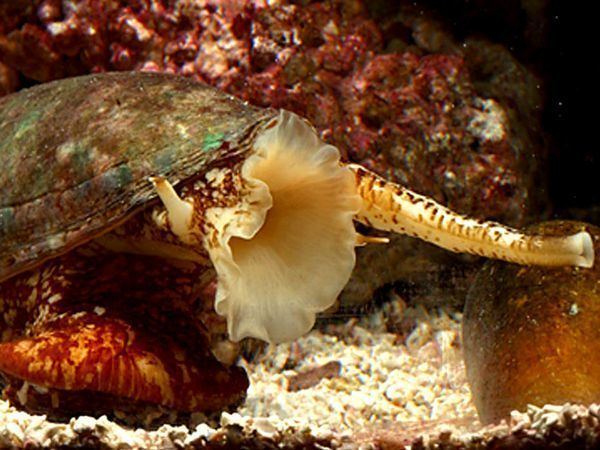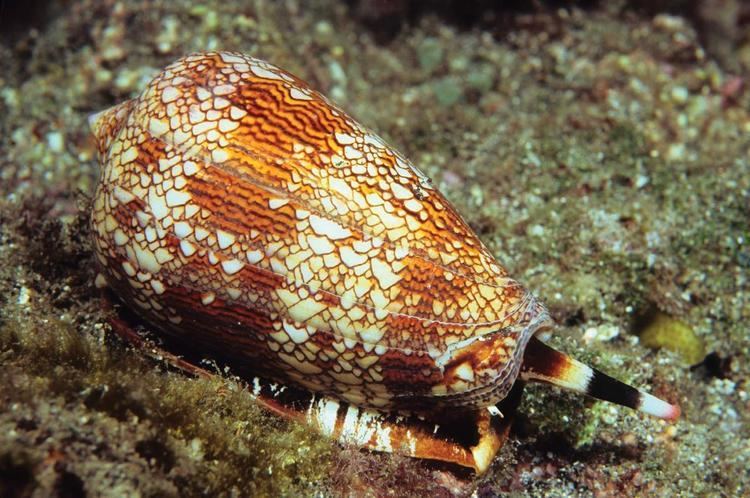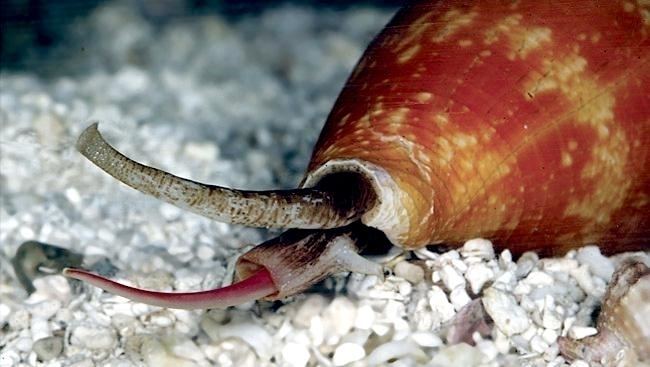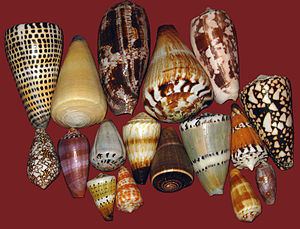 | ||
Killer cone snails national geographic
Cone snails, cone shells or cones are common names for a large group of small to large-sized predatory sea snails, marine gastropod molluscs.
Contents
- Killer cone snails national geographic
- Killer cone snails the nature of science
- Distribution and habitat
- Shell description
- Life habits
- Harpoon and venoms
- Risks
- Medical use of the venom
- Shell collecting
- As jewelry
- Species
- References

Until fairly recently, over 600 species of cone snails were all classified under one genus, Conus, in one family, the Conidae. However, in recent years, it was suggested that cone snails should occupy only a subfamily that should be split into a very large number of genera. A 2014 paper attempted to stabilize a newer classification of the group, significantly reducing the number of new genera, but keeping a fairly large number of subgenera. Although the taxonomy has changed significantly several times during recent years, in the current (2015) version of the taxonomy of these snails and their close relatives, cone snails once again comprise the entire family Conidae.

Geologically speaking, fossils of cone snails are known from the Eocene to the Holocene epochs. Cone snail species have shells that are shaped more or less like geometric cones. Many species have colorful patterning on the shell surface. Cone snails are almost all tropical in distribution.

Because all cone snails are venomous and capable of "stinging" humans, live ones should be handled with great care or preferably not at all. The species most dangerous to humans are the larger cones, which prey on small bottom-dwelling fish; the smaller species mostly hunt and eat marine worms. Cone snails use a hypodermic needle-like modified radula tooth and a venom gland to attack and paralyze their prey before engulfing it. The tooth, which is sometimes likened to a dart or a harpoon, is barbed and can be extended some distance out from the head of the snail, at the end of the proboscis.

Cone snail venoms are mainly peptides. The venoms contain many different toxins that vary in their effects; some are extremely toxic. The sting of small cones is no worse than a bee sting, but the sting of a few of the larger species of tropical cone snails can be serious, occasionally even fatal to humans. Cone snail venom is showing great promise as a source of new, medically important substances.

Killer cone snails the nature of science
Distribution and habitat
There are over 800 different species of cone snails. Cone snails are typically found in warm and tropical seas and oceans worldwide, and they reach their greatest diversity in the Western Indo-Pacific region. However, some species are adapted to temperate environments, such as the Cape coast of South Africa, the Mediterranean, or the cool waters of southern California (Conus californicus), and are endemic to these areas.
Cone snails are found in all tropical and subtropical seas, from the intertidal zone to deeper areas, living on sand or among rocks or coral reefs. When living on sand, these snails bury themselves with only the siphon protruding from the surface. Many tropical cone snails live in or near coral reefs. Some species are found under rocks in the lower intertidal and shallow subtidal zones.
Shell description
This group of sea snails shows a large variety of colors and patterns, and local varieties and color forms of the same species often occur. This has led to the creation of a large number of known synonyms and probable synonyms, making it difficult to give an exact taxonomic assignment for many snails in this genus. As of 2009, more than 3,200 different species names have been assigned, with an average of 16 new species names introduced each year.
The shells of cone snails vary in size. The shells are shaped more or less like the geometric shape known as a cone, as one might expect from the popular and scientific name. The shell is many-whorled and in the form of an inverted cone, the anterior end being the narrow end. The protruding parts of the top of the whorls that form the spire are more or less in the shape of another, much more flattened, cone. The aperture is elongated and narrow. The horny operculum is very small. The outer lip is simple, thin, and sharp, is without a callus, and has a notched tip at the upper part. The columella is straight.
The larger species of cone snails can grow up to 23 cm (9.1 in) in length. The shells of cone snails are often brightly colored and have interesting patterns, although in some species the color patterns may be partially or completely hidden under an opaque layer of periostracum. In other species, the topmost shell layer is thin periostracum, a transparent yellowish or brownish membrane.
Life habits
Cone snails are carnivorous, and predatory. They hunt and eat prey such as marine worms, small fish, molluscs, and even other cone snails. Because cone snails are slow-moving, they use a venomous harpoon (called a toxoglossan radula) to capture faster-moving prey, such as fish. The venom of a few larger species, especially the piscivorous ones, is powerful enough to kill a human being.
The osphradium (a chemoreceptory organ) is more highly specialized than the same organ in any other group of gastropods. It is through this sensory modality that cone snails become aware of the presence of a prey animal, not through vision. The cone snails immobilize their prey using a modified, dartlike, barbed radular tooth, made of chitin, along with a venom gland containing neurotoxins. Small species of these cone snails hunt small prey, such as marine worms, whereas larger cone snails hunt live fish.
Molecular phylogeny research by Kraus et al. (2010) based on a part of "intron 9" of the gamma-glutamyl carboxylase gene has shown that feeding on fish has evolved at least twice independently in the group.
Harpoon and venoms
Cone snails use a radula tooth as a harpoon-like structure for predation. Each of these harpoons is a modified tooth, primarily made of chitin and formed inside the mouth of the snail, in a structure known as the toxoglossan radula. (The radula in most gastropods has rows of many small teeth, and is used for grasping at food and scraping it into the mouth.) Each specialized cone snail tooth is stored in the radula sac (an everted pocket in the posterior wall of the buccal cavity), except the tooth that is currently ready to be used. The radular-tooth structures differ slightly according to the feeding mode of vermivorous, molluscivorous and piscivorous species.
The tooth is hollow and barbed, and is attached to the tip of the radula in the radular sac, inside the snail's throat. When the snail detects a prey animal nearby, it extends a long flexible tube called a proboscis towards the prey. The radula tooth is loaded with venom from the venom bulb and, still attached to the radula, is fired from the proboscis into the prey by a powerful muscular contraction. The venom paralyzes small fish almost instantly. The snail then retracts the radula, drawing the subdued prey into the mouth. After the prey has been digested, the cone snail will regurgitate any indigestible material, such as spines and scales, along with the then-disposable harpoon. There is always a dart stored in the radular sac. A dart may be used in self-defense when the snail feels threatened.
All cone snail species are equipped with a battery of toxic harpoons that can fire in any direction, even backwards. Some of these toxins can be fatal to humans.
The venom of cone snails contains hundreds of different compounds, and its exact composition varies widely from one species to another. The toxins in these various venoms are called conotoxins. These are various peptides, each targeting a specific nerve channel or receptor. Some cone snail venoms also contain a pain-reducing toxin, which the snail uses to pacify the victim before immobilising and then killing it.
Risks
The bright colors and patterns of cone snails are attractive to the eye, and therefore people sometimes pick up the live animals and hold them in their hand for a while. This is risky, because the snail often fires its harpoon in these situations. In the case of the larger species of cone snail, the harpoon is sometimes capable of penetrating the skin, even through gloves or wetsuits.
The sting of many of the smallest cone species may be no worse than that of a bee or hornet sting, but in the case of a few of the larger tropical fish-eating species, especially Conus geographus, Conus tulipa and Conus striatus, a sting can sometimes have fatal consequences. Other dangerous species are Conus pennaceus, Conus textile, Conus aulicus, Conus magus and Conus marmoreus. According to Goldfrank's Toxicologic Emergencies, only about 15 human deaths can be confidently attributed to cone snail envenomation.
Most of the cone snails that hunt worms rather than fish are probably not a real risk to humans, with the possible exception of larger species. One of the fish-eating species, the geography cone, Conus geographus, is also known colloquially as the "cigarette snail", a gallows humor exaggeration implying that, when stung by this creature, the victim will have only enough time to smoke a cigarette before dying.
Symptoms of a more serious cone snail sting include intense, localized pain, swelling, numbness and tingling and vomiting. Symptoms can start immediately or can be delayed in onset for days. Severe cases involve muscle paralysis, changes in vision, and respiratory failure that can lead to death.
Medical use of the venom
The appeal of the cone snail's venom for creating pharmaceutical drugs is the precision and speed with which the various components act; many of the compounds target a particular class of receptor, to the exclusion of any other. This means that, in isolation, they can reliably and quickly produce a particular effect on the body's systems without side effects; for example, almost instantly reducing heart rate or turning off the signaling of a single class of nerve, such as pain receptors.
Ziconotide, a pain reliever 1,000 times as powerful as morphine, was initially isolated from the venom of the magician cone snail, Conus magus. It was approved by the U.S. Food and Drug Administration in December 2004 under the name "Prialt". Other drugs are in clinical and preclinical trials, such as compounds of the toxin that may be used in the treatment of Alzheimer's disease, Parkinson's disease, depression, and epilepsy.
Many peptides produced by the cone snails show prospects for being potent pharmaceuticals, such as AVC1, isolated from the Australian species, the Queen Victoria cone, Conus victoriae. This has proved very effective in treating postsurgical and neuropathic pain, even accelerating recovery from nerve injury.
Shell collecting
The intricate color patterns of cones have made them one of the most popular collectible shells.
Conus gloriamaris, the "Glory of the Seas" cone, was, in earlier centuries, one of the most famous and sought-after seashells, with only a few specimens in private collections. This apparent rarity meant that shells of this species fetched very high prices, until finally the habitat for this cone was discovered. Sizable populations were then located, and this brought the price down dramatically.
As jewelry
Naturally-occurring, beachworn cone shell "tops" (the broken-off spire of the shell, which usually end up with a hole worn at the tip) can function as beads without any further modification. In Hawaii, these natural beads were traditionally collected from the beach drift to make puka shell jewelry. Since it is hard to obtain enough naturally-occurring cone tops, almost all modern puka shell jewelry uses cheaper imitations, cut from thin shells of other species of mollusk, or even made of plastic.
Species
Prior to 2009, all species within the family Conidae were still placed in one genus Conus. Testing in order to try to understand the molecular phylogeny of the Conidae was initially begun by Christopher Meyer and Alan Kohn, and is continuing, particularly with the advent of nuclear DNA testing in addition to mDNA testing.
In 2009, J.K. Tucker and M.J. Tenorio proposed a classification system consisting of three distinct families and 82 genera for the living species of cone snails. This classification was based on shell morphology, radular differences, anatomy, physiology, and cladistics, with comparisons to molecular (DNA) studies. Published accounts of genera within the Conidae that use these new genera include J.K. Tucker & M.J. Tenorio (2009), and Bouchet et al. (2011). Tucker and Tenorio's proposed classification system for the cone shells and their allies (and the other clades of Conoidean gastropods) is shown in Tucker & Tenorio cone snail taxonomy 2009.
Some experts, however, preferred to use the traditional classification, where all species are placed in Conus within the single family Conidae: for example, according to the November 2011 version of the World Register of Marine Species, all species within the family Conidae were placed in the genus Conus. The binomial names of species in the 82 genera of living cone snails listed in Tucker & Tenorio 2009 were recognized by the World Register of Marine Species as "alternative representations". Debate within the scientific community regarding this issue continued, and additional molecular phylogeny studies were being carried out in an attempt to clarify the issue.
In 2015, in the Journal of Molluscan Studies, Puillandre, Duda, Meyer, Olivera & Bouchet presented a new classification for the old genus Conus. Using 329 species, the authors carried out molecular phylogenetic analyses. The results suggested that the authors should place all cone snails in a single family, Conidae, containing four genera: Conus, Conasprella, Profundiconus and Californiconus. The authors group 85% of all known cone snail species under Conus. They recognize 57 subgenera within Conus, and 11 subgenera within the genus Conasprella.
